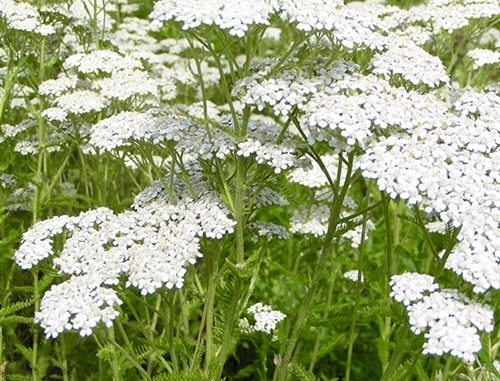
When I lived in my home in town I planted quite a few Yarrow plants in my garden due to the fact that I loved the varying color of its blossoms and the hardiness of this perennial. When I first planted it I had no idea about the amazing healing properties of this tiny little flower.
Over the course history this plant has been called by many different names such as Milfoil, Woundwort, Arrowroot, Carpenter’s Plant, Soldier’s Woundwort and a few others that I won’t bother to mention because I feel as though they are an insult to this plant. The plant grows approximately 12 to 36 inches tall with usually small clusters of white flowers and fern like leaves. I have noticed that while harvesting this plant in my local area that it seems to prefer to grow along the roadside’s rather than in the field where it competes less with other plants.
Medicinal Uses
This plant was used in ancient times crushed into a poultice and put directly into wounds to stop bleeding and prevent infection. The plant has extremely strong coagulant properties and the fernlike leaves are the source for making styptic powder. This same poultice was also used in ancient times to stop heavy life-threatening bleeding after childbirth when pressed against the uterus.
Besides it’s coagulant properties it also has an anti-inflammatory and antibacterial effect or astringent affect on wounds, it can also relax peripheral blood vessels, be used as a digestive stimulant, and is a restorative for the menstrual system. Other healing properties mentioned are that it was used as a anti-diarrheal, treatment for fever, to treat not just external bleeding but also internal bleeding and to treat kidney and bladder infections.
Finally other uses mentioned are that it can stop nose bleeds, be applied to breast abscesses, used as a hair rinse, relieves headaches, reduces adema, and can be applied to the chest and back in the form of a salve or poultice to treat bronchitis.
Preparations
This plant can be used in many different preparations such as a poultice, salve, tea, dried powder snuff, oil infusion, tincture, vapor and essential oil.
A poultice of the plant requires fresh plant flowers, leaves and stem to be crushed to a mush, and I find that a food processor works well for this. This poultice can be stored in the freezer for a short period of time and thawed out as needed.
To make a salve dry the plant out and then cut it up and put it into a mason jar (1 part dried plant to 1 part oil) and allow it to sit in olive oil for at least two weeks to 1 month to infuse the oil with the plant. If you need it quicker than two weeks to 1 month then my suggestion is to gently warm the dried herb into the oil, but make sure to not overheat it. Then strain the plant out and add beeswax until properly thickened usually 1 1/2 ounces of beeswax for each pint of oil.
Another preparation type is tea, which can boost immunity and be used to ease the discomfort of a cold or flu. This tea recipe is recommended by “The Herbal Drugstore” written by Linda B. White M.D. and Steven Foster.
Cold and Flu Brew
2 1/4 tsp echinacea leaf
2 1/4 tsp elder flowers
2 1/4 tsp yarrow leaves and flowers
1 1/4 tsp peppermint
3 cups water
Place all but the peppermint leaves in the water and simmer, covered, for 10 to 15 minutes. Remove from heat and add the peppermint. Steep, covered, for 10 minutes. Strain herbs and discard. Drink up to 3 cups of tea per day as needed. Stored in the refrigerator for up to three days.
The dried powder snuff is created by fine grinding the dried herb with a coffee grinder and was snuffed to treat headaches. Yet, I highly recommend purchasing this form from a master herbalist or doctor and following their instructions. Due to the fact that this preparation is a highly concentrated forms of the plant and flowers and should be taken with supervision.
In the book “Home Herbal” the tincture (a preparation of the herb in alcohol or glycerin) dosage recommend is 20 to 40 drops 3 times daily for urinary disorders. This book also recommends 10 drops of essential oil (a distilled form of the herb that is highly concentrated) to 5 tsp of infused St. John’s wort oil to make a rub for hot, inflamed joints. It also recommends a steam inhalation dosage of 1 tablespoon fresh flowers in boiling water to ease hayfever symptoms. Inhale the steam for at least 2 to 3 minutes.
Recommend Dosages
Recommended dosage will very on preparation type as well as what ailment is being treated with the plant. The book “Herbs That Heal” written by Micheal A. Weiner Ph.D. and Janet A. Weiner recommendation for dried leaves and flower tops is approximately 1/2 an ounce of the leaves and flower tops to 1 pint of water. Boil water separately and pour over the plant material and steep for 5 to 20 minutes, depending on desired effect. Drink hot or warm, 1 to 2 cups or more per day, at bedtime and upon awakening.
Cautions
Drinking the tea and applying the herb can increase sensitivity to light (photosensitivity). The tea may contain small amounts of thujone, a carcinogen and liver toxin. Allergic reactions are possible, as is true of all plants. Due to its uterine-stimulating propensity, do not take yarrow internally while pregnant or nursing.
As always consult a doctor who is familiar with herbalism and/or a master herbalist for the exact dosage required for the intended purpose or when blending this wild herb with other wild herbs.
Harvest Time
The best time to harvest this plant is when it blooms from early to mid summer. All parts of the plant can be used such as the bloom, stem and leaf. It prefers to grow around the sides of roads and paths in direct sun, but can also be found growing in the field. While Yarrow usually has white flowers domestic varieties may have yellow, pink or orange flowers.
Spiritual Properties
According to the book “Cunningham’s Encyclopedia of Magical Herbs” by Scott Cunningham yarrow is under the influences of the feminine gender, the planet Venus and the element of water. The common energies it holds sway over is love, courage, psychic powers and exorcism.
“When worn, yarrow protects the wearer, and when held in a hand, it stops all fears and grants courage.
A bunch of dried yarrow hung over the bed or yarrow used in wedding decorations ensures a love lasting at least seven years. Yarrow is also used in love spells.
Carrying yarrow not only brings love, but it also attracts friends and distant relations you wish to contact. It draws the attention of those you most want to see.
The flowers are made into an infusion and the resulting tea is drunk to improve psychic powers.
Washing the head with yarrow infusion will prevent baldness, but won’t cure it if it has already begun.
Yarrow is also used to exercise evil and negativity from a person, place or thing.”
Supporting References
Breverton, Terry: Breverton’s Complete Herbal. Guilford, Connecticut, Lyons Press 2011. Based on Culpeper’s The English Physitian and Compleat Herball of 1653. (Yes, it is misspelled right.)
Bown, Deni: The Royal Horticultural Society New Encyclopedia of Herbs & Their Uses. London, Dorling Kindersley 2002.
Cunningham, Scott: Cunningham’s Encyclopedia of Magical Herbs. St. Paul, MN, Llewelyn Publications 1990.
Hensel, Wolfgang: Medicinal Plants of Britain and Europe. London, A&C Black Publishers Ltd. 2008.
Meuninck, Jim: Medicinal Plants of North American. Guilford, Connecticut, Morris Book Publishing 2008.
Ody, Penelope: The Complete Medicinal Herbal. New York, NY, DK Publishing, Inc. 1993.
Neal’s Yard Remedies (Julie Wood, Elly Phillips, Dr. Pauline Hili and Dr. Merlin Wilcox): Home Herbal. New York, New York, DK Publishing, Inc. 2011.
Peterson, Lee Allen: Edible Wild Plants Eastern/Central North America. Boston, New York, Houghton Mifflin Company 1977.
van Wyk, Ben-Erik & Michael Wink: Medicinal Plants of the World. Portland, Oregon, Timber Press 2004.
Weiner, Micheal A. Ph.D. & Janet A. Weiner: Herbs That Heal. Mill Valley, California, Quantum Books 1994.
White, Linda B. M.D. & Steven Foster: The Herbal Drugstore. USA, Rodale Inc. 2000.
Williams, Jude C.: Jude’s Herbal Home Remedies. St. Paul, MN, Llewelyn Publications 2001.


Leave a Reply